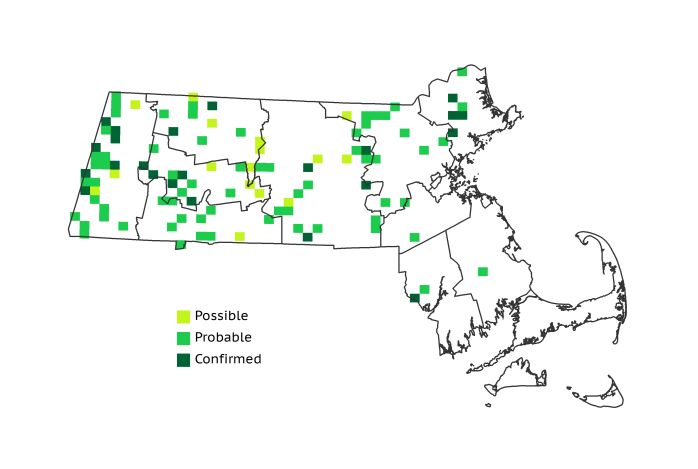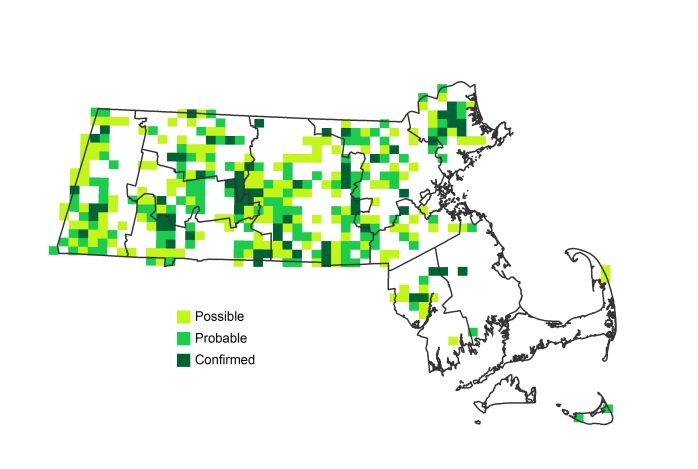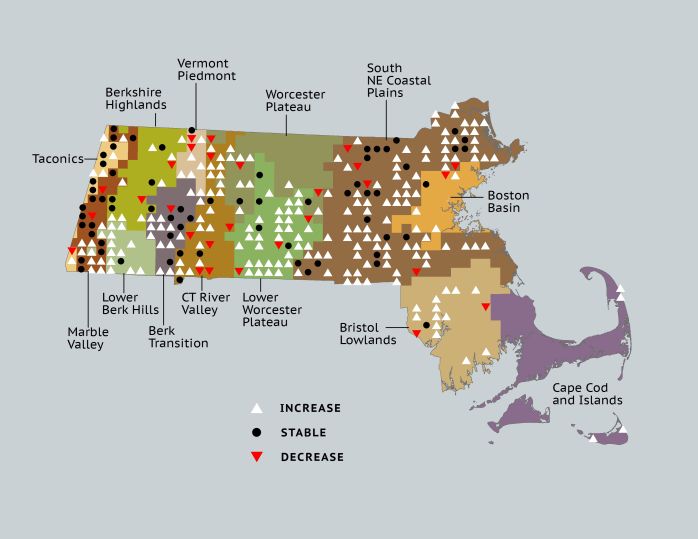Find a Bird
Yellow-throated Vireo
Vireo flavifrons

Somewhat local and strongly increasing
“There can be no reasonable doubt that with an annual consumption of 42.25 per cent of caterpillars and moths, the yellow-throated vireo is to be classed as a beneficial bird…. This is a record to commend the yellow-throated vireo, and one that is not closely approached by other birds of this family.” – Edward A. Chapin, Food Habits of the Vireos: A Family of Insectivorous Birds
Of all our breeding vireos, the Yellow-throated Vireo is the most visually striking. Unlike the brush-skulking White-eyed Vireo, the Yellow-throated Vireo lives amidst the higher branches of open deciduous forests. Yellow-throated Vireo populations have fluctuated with the changes in the Massachusetts landscape for hundreds of years. Currently, it seems that the species has managed to find a niche within these ever-changing forests.
Historic Status
In the 1830s, Yellow-throated Vireos were typically a forest species, but the state was changing during that period (Peabody 1839). As forests disappeared, farms gradually took their place, and in many cases these newly cleared landscapes included orchards. Yellow-throated Vireos quickly took to orchards as their new sanctuaries, just as they would to Beaver-created openings in the regenerating forests of Massachusetts a century later. During the latter half of the nineteenth century, observers described the Yellow-throated Vireo as a common summer resident in Massachusetts (Howe & Allen 1901). Edward Howe Forbush noted the beginning of their decline in Massachusetts when he wrote that the species was a “formerly common summer resident, though rather local, recently becoming rare in the eastern part” (Forbush 1929). The species continued to decline for the next few decades.
Atlas 1 Distribution
Yellow-throated Vireos were still broadly distributed at the time of Atlas 1, but their occupancy was patchy. The return of Beavers to the western part of the state had created more of the wet forest openings that Yellow-throated Vireos preferred, so the low-lying Marble Valleys enjoyed 44% occupancy. The Berkshire Transition and Connecticut River Valley also seemed to be favored areas. The forests in the Worcester Plateau often had too much elevation for the vireos, or were too coniferous in their forest cover, but the Lower Worcester Plateau hosted Yellow-throated Vireos in a modest but noticeable 18% of blocks. They were present but scattered in the Coastal Plains, and a few were also recorded in the northern Boston Basin. Three blocks in the Bristol/Narragansett Lowlands represented the most southeasterly extent of the species’ badly reduced population distribution.
Atlas 2 Distribution and Change
In Atlas 2, Yellow-throated Vireos seemingly returned with a vengeance. Every region in the state during Atlas 2 finished with more Yellow-throated Vireos present than they had in Atlas 1, and in some cases these gains were remarkable. In the west, when looking at the most well-surveyed blocks, Yellow-throated Vireos newly occupied half of the Lower Berkshire Hills region, as well as steadily expanding in all surrounding regions. The increase in the Connecticut River Valley was noticeable but not astronomical; the Lower Worcester Plateau, on the other hand, reported Yellow-throated Vireo breeding activity in more than 35 new blocks overall. Yellow-throated Vireos also took the Coastal Plains by storm, with breeding evidence found in a noteworthy 45% of all blocks in that large region. Although their presence in the Boston Basin and the Bristol/Narragansett Lowlands was still relatively modest, their occupation of the Cape and Islands affirms that Yellow-throated Vireos may be returning to the maturing forests they once called home.
Atlas 1 Map

Atlas 2 Map

Atlas Change Map

Ecoregion Data
Atlas 1 | Atlas 2 | Change | ||||||
Ecoregion | # Blocks | % Blocks | % of Range | # Blocks | % Blocks | % of Range | Change in # Blocks | Change in % Blocks |
Taconic Mountains | 7 | 43.8 | 6.6 | 19 | 76.0 | 5.2 | 4 | 26.7 |
Marble Valleys/Housatonic Valley | 17 | 43.6 | 16.0 | 26 | 66.7 | 7.1 | 7 | 17.9 |
Berkshire Highlands | 7 | 12.7 | 6.6 | 11 | 20.0 | 3.0 | 0 | 0.0 |
Lower Berkshire Hills | 1 | 3.6 | 0.9 | 16 | 51.6 | 4.3 | 12 | 44.4 |
Vermont Piedmont | 4 | 23.5 | 3.8 | 9 | 52.9 | 2.4 | 2 | 16.7 |
Berkshire Transition | 8 | 21.1 | 7.5 | 25 | 62.5 | 6.8 | 11 | 35.5 |
Connecticut River Valley | 10 | 17.9 | 9.4 | 26 | 40.0 | 7.1 | 13 | 27.1 |
Worcester Plateau | 6 | 7.7 | 5.7 | 27 | 30.7 | 7.3 | 8 | 16.7 |
Lower Worcester Plateau | 13 | 17.6 | 12.3 | 55 | 68.8 | 14.9 | 27 | 50.0 |
S. New England Coastal Plains and Hills | 28 | 10.4 | 26.4 | 127 | 44.9 | 34.5 | 80 | 35.4 |
Boston Basin | 2 | 3.6 | 1.9 | 8 | 14.3 | 2.2 | 5 | 9.1 |
Bristol and Narragansett Lowlands | 3 | 2.8 | 2.8 | 16 | 14.0 | 4.3 | 11 | 10.9 |
Cape Cod and Islands | 0 | 0.0 | 0.0 | 3 | 2.1 | 0.8 | 3 | 2.5 |
Statewide Total | 106 | 10.9 | 100.0 | 368 | 35.5 | 100.0 | 183 | 22.1 |
Notes
In accordance with Atlas increases, the Yellow-throated Vireo shows a significant increasing Breeding Bird Survey trend in Massachusetts.



